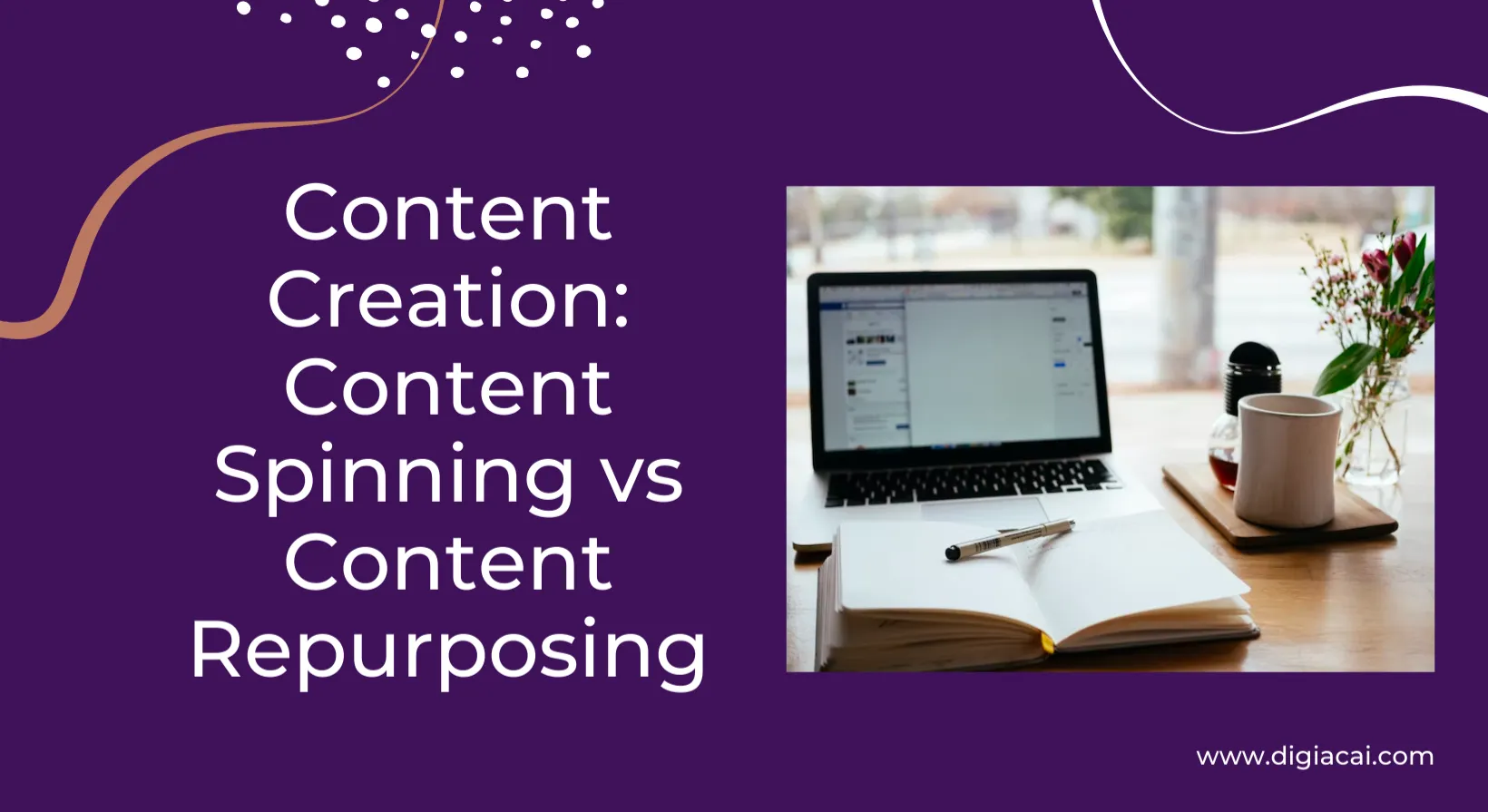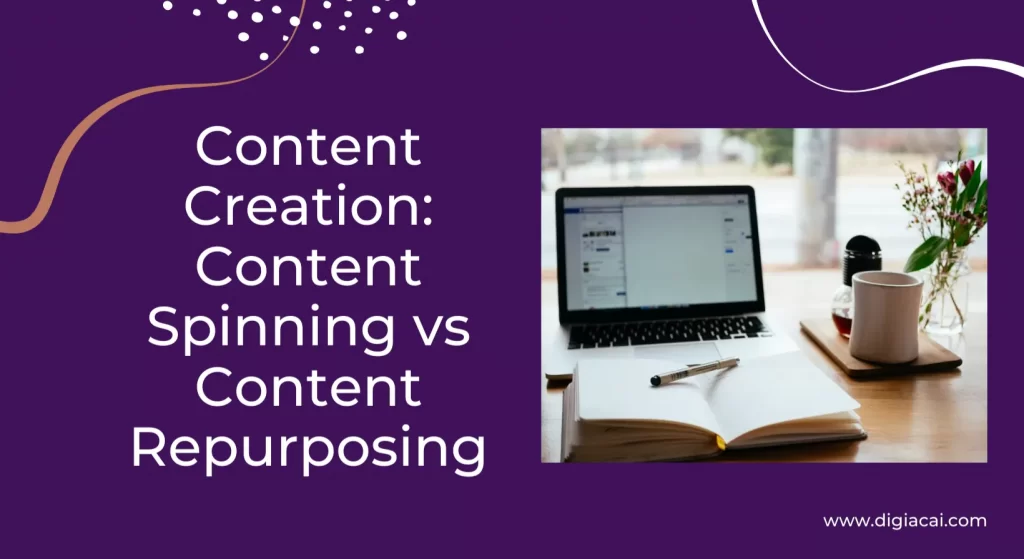Content creation is essential to digital marketing, and businesses often need help to create enough quality content to keep their online presence active and engaging. Many companies turn to content spinning and repurposing as two methods of quickly and efficiently producing new content to combat this. This blog will explore the differences and similarities between these two methods, their advantages and disadvantages, and which one may best suit your content strategy.
Content Spinning
Content spinning is a popular method marketers, and website owners use to generate multiple versions of an article or blog post quickly. The software used for content spinning can often produce dozens, if not hundreds, of unique variations of the original piece of content.
While content spinning may seem like an efficient way to quickly produce a large amount of content, it is not always the best approach. Spun content can often be of low quality and may not provide value to the reader. Additionally, search engines are becoming increasingly sophisticated at detecting spun content and may penalise websites that use it.
Advantages of Content Spinning:
- Increased Website Traffic: Content spinning can help improve the content on a website. By creating multiple versions of the same content, a website can have more pages to index and display in search results, leading to more organic traffic.
- Improved SEO: Using content spinning, website owners can create unique versions of their content by replacing certain words or phrases with synonyms. This can help avoid duplicate content penalties from search engines. Additionally, content spinning can create multiple pieces of content that target different variations of keywords, which can improve a website’s search engine ranking for those keywords.
- Cost-Effective Way to Produce Content: Creating new content from scratch can be time-consuming and expensive. Content spinning, on the other hand, is a more cost-effective way to produce content. By using existing content as a starting point, website owners can create new versions of that content without having to invest as much time or money as they would in creating completely unique content.
Disadvantages of Content Spinning:
- Decreased quality content:Content spinning often results in lower quality content than original content. Spinning software may need help accurately capturing the nuances and context of the original content, resulting in poorly written and uninformative articles.
- Duplicate content: When content is spun, it can often be flagged as duplicate content by search engines. Duplicate content can lead to a lower search engine ranking, which can negatively impact the visibility and traffic of your website.
- Lack of originality: Spun content can often lack originality, making it less engaging and unlikely to be shared. Original content is key to engaging your audience and building a strong online presence.
- Inaccuracy and errors: Spinning software may not always produce accurate and error-free content. This can be particularly problematic in industries such as finance, medicine, or law, where inaccuracies can have serious consequences.
- Legal issues: Content spinning can potentially violate copyright laws, particularly if the original content is not properly attributed or spun without permission from the original author. This can result in legal issues and damage to your reputation.
Content Repurposing
Content repurposing is the process of taking an existing piece of content and modifying it to serve a new purpose or reach a different audience. It transforms content into various formats, such as audio, video, images, or social media posts.
By repurposing content, you can leverage the value of your created content and increase its reach. For instance, you can turn a blog post into an engaging video or create an infographic from a long-form white paper. By doing this, you can expand your audience, engage your existing followers in new ways, and improve your brand’s visibility across multiple platforms.
Content repurposing is a cost-effective strategy for marketers. It allows them to create multiple pieces of content from a single source, reducing the time, effort, and resources required to produce new content.
Advantages of Content Repurposing
- Brand Exposure: By repurposing content for different platforms, businesses can reach new audiences and increase brand exposure.
- Reuse Valuable Content: Repurposing valuable content allows businesses to get more mileage from existing content, making it more cost-effective.
- Increase Engagement with Audience: Repurposing content in different formats can help to engage audiences in different ways and reach those who prefer different types of content.
Disadvantages of Content Repurposing
- Limited Opportunities for Audience: Repurposing content for different platforms may only reach new audiences if optimised content.
- Time-Consuming: Repurposing content can be time-consuming, especially if it involves creating new content from scratch.
Differences and Similarities between Content Spinning and Content Repurposing
Content spinning aims to produce unique content quickly and easily, while content repurposing involves adapting existing content for new purposes. Both methods are more cost-effective than creating entirely new content from scratch, and they can improve website traffic and SEO when executed properly.
However, content spinning often involves using software to automatically replace words and phrases with synonyms or alternative words, leading to lower-quality content that lacks originality and may even be considered duplicate content, which can harm a website’s SEO.
On the other hand, content repurposing requires more time and effort but can provide the following:
- Increased brand exposure.
- Greater engagement with the audience.
- The ability to reuse valuable content.
Conclusion
To conclude, while content spinning may provide a fast way to create content, it can lead to lower quality and duplicate content that can harm a website’s SEO. On the other hand, content repurposing enables businesses to maximize the value of existing content by presenting it in different formats to engage and reach new audiences.
Although it may require more time and effort, content repurposing offers a variety of benefits, such as increased brand exposure, greater audience engagement, and the ability to reuse valuable content.
Ultimately, the decision to choose between content spinning and repurposing depends on your content strategy and goals. However, if you want to establish a strong online presence, engage your audience, and become a thought leader in your industry, content repurposing is the way to go.







